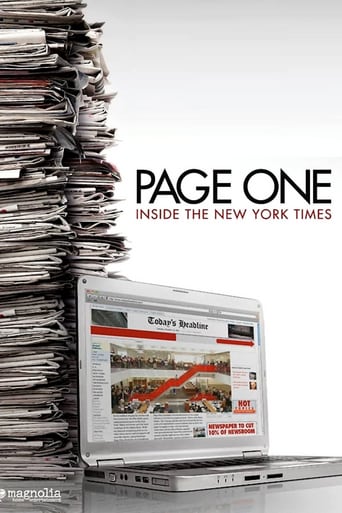Mr-Fusion
"Page One" promises a look inside the New York Times, but it's also focused on the question that looms large over the whole industry: how can print journalism sustain itself? It's a worthy question, and goodness knows the movie devotes plenty of time to the issue. And if you're on the side of legacy journalism, then revel in the film's best character, David Carr (print's staunchest defender). This guy's all teeth. It's a fun scene watching him shoot down an aggregator during a debate.But the movie's at its best when it's about the newsroom, and this is compelling stuff: decisions being made during the Wikileaks info dump, Iraq withdrawal, and the laying off o a great deal of the paper's workforce. You do get to be a fly on the wall, and during these scenes, it's good stuff.7/10
Sam Boutelle
Intimidating as it inspires, Page One pushes cameras into one of the highest-pressure environments around and captures a few human moments in the midst of empire-cleaving times. As he explores the prognosis for the Gray Lady, Andrew Rossi also lends light to lives led in pursuit of larger issues, and he illuminates just how frantic days are within the halls and heads of those responsible for the paper of record. Best of all, we're allowed to be entertained by journalists who otherwise appear only in text that has been scraped and stapled by an institution until its fit to print. More than the documentary's macro plunge into the fate of print media, it is these nicks and knacks of picking up Twitter and trying to break through to clarity in reporting that defines Page One as an inside scoop.
CurtHerzstark
When Johann Gutenberg invented the printing process around 1439, he probably couldn't foresee the future, where people would consider his invention redundant and obsolete.The digital revolution , internet, etc have started to compete with printed media such as the legendary newspaper The New York Times, a newspaper that is depicted in this documentary.We get follow some of their reporters, the job at the editing office, and also the new approach to the internet and surfpads.But will The New York Times be able to compete with websites like Wikileaks etc? And how will they survive in climate with ever descending ad incomes? Will the internet completely destroy investigating journalism? Because nowadays anyone can be investigating journalist by simply putting their discoveries on a personal blog or any other type of internetbased platform.These and many other questions are discussed in this highly interesting documentary about media from one of the most prominent newspapers in the world.The documentary also touches upon the heavy criticisms that newspaper received during the Judith Miller, Jayson Blair scandals and ever growing question, can we trust media at all? The only flaws I can think of is that sometimes director Andrew Rossi seem to lack focus, not knowing what he wants to tell, he should made the viewers get closer to some of the people working at the New York Times.I would love to know more about David Carrs background, a colourful journalist, and some of his co workers background.But this film should been seen by anyone wanting to know more about media, journalism in this riveting documentary. So viewers who liked Outfoxed: Rupert Murdoch's War on Journalism (2004), The Most Dangerous Man in America: Daniel Ellsberg and the Pentagon Papers (2009), Starsuckers (2009) should see this one.
jysting
In his review of the documentary Page One: Inside the New York Times (Paper thin insights, Weekend Australian Review Sept 24-25) Lynden Barber ascribes "pomposity" to the Time's "olde-timey font and (page) layout." I disagree- in its bid to be more appealing and easier to read, the layout and font chosen are tastefully attention-drawing and pleasing to look at. Indeed I consider the highly characteristic New York Times nameplate a historical objet d'art. Such strongly-felt reactions to the visual elements of typography used by the New York Times suggests that the typeface form of letters selected for headlines and article text as well as page layout are designed to evoke visceral responses in profoundly subliminal ways. The impact of fonts and page layouts is not just an esoteric aside. The style used for letters, characters and text are designed to create a readable, coherent and visually satisfying whole that works without the reader being aware.Where spoken language relies on tone of voice or gesture to convey emotion, the visual form of the written word possesses mysterious connotative properties. Ultimately, a world without charismatically constructed letters, numerals and symbols leads to unengaging newspapers, whether online or in print. Joseph Y Ting

